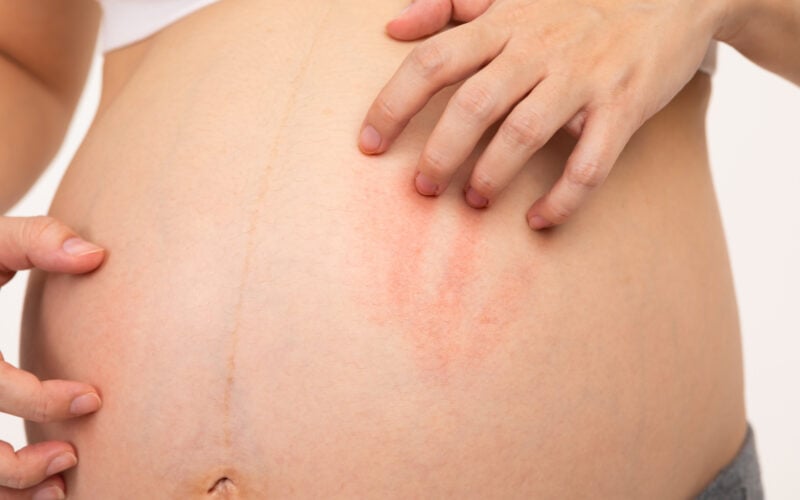It’s no secret that pregnancy brings with it a whole host of physical changes—some of them unwelcome. During the nine months of pregnancy, a staggering 90% of women can expect to have “significant and complex” skin changes [1]. Some of these skin changes can be anticipated, like stretch marks and linea nigra, a dark line that runs from the belly button downward. However, there are some skin issues that go beyond the frustrating, like PUPPP, and can venture into being a health concern, like pemphigoid gestationis. Here’s a guide to skin changes during pregnancy—what’s common, what’s merely annoying, and what merits a trip to your doctor.
Common and benign skin changes during pregnancy
Stretch Marks
Stretch marks, otherwise known as striae gravidarum, occur in up to 90% of women in their third trimester. These red or pinkish striations can appear on the belly, breasts, or limbs. There are countless stretch mark creams on the market. But there isn’t really any research to support ingredients like Vitamin E cream or cocoa butter working to prevent or decrease stretch marks during pregnancy. There is some evidence suggesting that centella or hyaluronic acid might prevent stretch marks. Products with these ingredients are generally difficult to find and have not been adequately researched for safety during pregnancy. Stretch marks will typically fade and shrink postpartum, though they will likely not disappear completely.
Hyperpigmentation
Most women also can expect to experience hyperpigmentation in one form or another during pregnancy. Hyperpigmentation is a normal bodily response that occurs due to heightened levels of hormones such as estrogen and progesterone during pregnancy. Its effects can be seen from the beginning of pregnancy. If you notice your freckles, moles, or nipples getting darker as you move through your first trimester, this is hyperpigmentation [1].
Linea nigra, another common type of hyperpigmentation, is a dark line that runs down the middle of the belly. It is often more pronounced in women of a darker complexion. It will typically disappear in the first few months postpartum. Melasma, or the ‘mask of pregnancy’, is another form of hyperpigmentation. Melasma is less common and takes the form of dark blotchy patches on the face which can sometimes look like freckles. This skin condition can stick around postpartum, but there are dermatological treatments which can help minimize it.
Acne
Did you think you left acne behind in high school? Unfortunately, acne often crops up again for women during pregnancy. This happens due to the excess production of sebum, or oil, in the skin. Acne during pregnancy is no different from any other kind of acne. It can generally be treated and prevented with basic hygiene and typical treatments. Make sure to wash your face and hair regularly and avoid picking at blemishes. Keep your hands off of your face as much as you can.
Common acne treatments like erythromycin or benzoyl peroxide are considered safe during pregnancy. Other products such as retinoids should be avoided during this time. Make sure to consult your doctor about any topical or oral medications used to treat acne during your pregnancy.
Varicose Veins/Spider Veins
Two more common skin changes during pregnancy are spider veins and varicose veins. Spider veins are small red veins which can pop up during early pregnancy on the face, neck or arms. They are caused by hormonal shifts and increased blood flow during pregnancy. They will usually fade after birth.
Varicose veins, on the other hand, are much larger and are located on the lower half of the body. Oftentimes they cause soreness. The best way to ease varicose veins is to not stay seated in one position for long periods of time. Also, wear support stockings to encourage blood flow. Luckily, this painful symptom should go away after delivery as well.
Unusual and concerning skin changes during pregnancy
Pruritic urticarial papules and plaques of pregnancy (PUPPP)
Pruritic urticarial papules and plaques of pregnancy, or PUPPP, is an itchy red rash that begins on the abdomen and sometimes spreads to the limbs. It typically begins in the third trimester, and has no adverse effects on the health of the pregnancy or the growing baby [2]. Your doctor may prescribe topical steroids and antihistamines to help with the itchiness. PUPPP is more common than the other skin issues listed below, and affects around 1 in every 130 to 300 pregnancies [2]. If you have any sort of itchy rash that won’t go away during your pregnancy, it is best to consult your doctor. He or she can determine if you have PUPPP and could be helped by topical or oral medications during this time.
Prurigo of pregnancy
Prurigo of pregnancy, similar to PUPPP, is an itchy red rash which forms clusters around the body. Unlike PUPPP, the rash doesn’t necessarily come from the growing belly. Instead, it can be located anywhere on the body. Prurigo of pregnancy could be caused by a number of factors, such as immunological or allergy changes. It doesn’t cause any risk to your growing baby. A doctor can help you determine if you have prurigo of pregnancy and help you choose the medication which will best ease your symptoms.
Pemphigoid gestationis
Pemphigoid gestationis is a rare diagnosis that occurs in around 1 out of every 50,000 pregnancies[1]. It takes the form of itchy lesions which then evolve into round blisters. These blisters cover the abdomen and other areas of the body. Pemphigoid gestationis differs from both PUPPP and prurigo of pregnancy in that it is likely to flare up again during both subsequent pregnancies or with oral contraceptive use [2].
There is risk of preterm birth and smaller newborns with pemphigoid gestationis. In a tiny percent of cases, the mother’s antibodies can carry to the developing baby and cause similar blisters for the newborn. There is no data to suggest an increase in risk of fetal death. Still, it is very important to seek the guidance of your doctor if you begin having itchy lesions or blisters of any kind during pregnancy. He or she will more closely monitor your pregnancy through the third trimester. Similar medications can be used to help with the itchiness as with PUPPP and prurigo of pregnancy.
Intrahepatic cholestasis of pregnancy (ICP)
Intrahepatic cholestasis of pregnancy (ICP) is a liver condition in which the flow of bile begins to slow down. This causes a slow build up in the blood. This build up of bile causes intense itchiness, concentrated in the hands and feet. ICP is fairly rare, occurring in around 1 out of every 1000 pregnancies, but often will return during subsequent pregnancies. ICP brings with it several risks for the developing baby. These include passing meconium in the womb, respiratory distress for the newborn, preterm spontaneous labor, and stillbirth. There are treatments for ICP to relieve itchiness and decrease adverse effects on the baby. Women with ICP will have their bile levels monitored closely by their doctor [2]. If you have ICP, you might be induced to deliver early based on your bile acid levels at the end of pregnancy.
Impetigo herpetiformis
Impetigo herpetiformis is a rare dermatological disorder which is still being studied to fully understand its causes. Along with lesions on the lower half of the body, impetigo herpetiformis can include symptoms like fever, chills, nausea, diarrhea, and vomiting [2]. There is increased risk to the fetus with this diagnosis. Complications include intrauterine growth restriction (IUGR), premature rupture of membranes (PROM), and stillbirth [3]. The type and amount rate of fetal risk is still being determined, and treatment guidelines are still being established [2]. Despite this, it is still imperative to inform your doctor if you begin to experience any types of lesions or unusual psoriasis during pregnancy, especially if accompanied by the other symptoms listed above.
What to look out for and when to see your doctor
All of this information might seem daunting. But remember, the majority of skin changes during pregnancy are limited to stretch marks, linea nigra, acne, and the like. These kinds of changes are normal and to be expected, though it can be disheartening at times to see your body changing in ways you might not like.
If you notice any types of rash, blisters, or excess itchiness, it’s time to call your doctor to make sure there isn’t something else going on. Many of these unusual skin disorders can be diagnosed based on the appearance of the skin lesions or rash, and ICP can be diagnosed with a simple blood test.
A reminder about normal vs. abnormal itching
It is important to note that some level of itchiness during pregnancy is normal, as the skin of your abdomen can get itchy from the stretching it undergoes as your baby grows. But, if you have intensely itchy hands and feet or if the itchy belly is accompanied by any sort of rash (or cannot be soothed with moisturizing), it is vital that you inform your doctor of these symptoms. During pregnancy, you are your best advocate, and being informed about what’s normal and what could be a cause for concern is an important step in taking charge of your health.
References:
[1] Vora RV, Gupta R, Mehta MJ, Chaudhari AH, Pilani AP, Patel N. Pregnancy and skin. J Family Med Prim Care. 2014 Oct-Dec;3(4):318-24. doi: 10.4103/2249-4863.148099. PMID: 25657937; PMCID: PMC4311336. [2] Tunzi, Marc, and Gary R Gray. “Common skin conditions during pregnancy.” American family physician vol. 75,2 (2007): 211-8. [3] Namazi N, Dadkhahfar S. Impetigo Herpetiformis: Review of Pathogenesis, Complication, and Treatment. Dermatol Res Pract. 2018 Apr 4;2018:5801280. doi: 10.1155/2018/5801280. PMID: 29849579; PMCID: PMC5904797.Additional Reading:
The surprising health benefits of pregnancy
Tylenol use during pregnancy: to take or not to take?
Cervical checks during pregnancy—what they can— and can’t tell you







